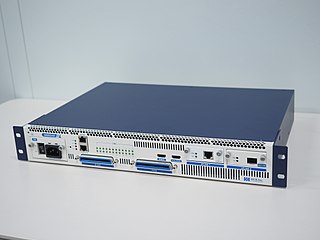
A digital subscriber line access multiplexer is a network device, often located in telephone exchanges, that connects multiple customer digital subscriber line (DSL) interfaces to a high-speed digital communications channel using multiplexing techniques. Its cable internet (DOCSIS) counterpart is the cable modem termination system.

iiNet Limited is an Australian internet service provider and telecommunications company that sells NBN plans, 4G and 5G Home Wireless Internet and services on its ULTRA Broadband Cable, FTTB and VDSL2 networks. It also sells mobile phone sim-only plans using the Vodafone network.

Internode Pty Ltd is an Australian Internet service provider (ISP) that provides NBN broadband services, business-class broadband access, web hosting, co-location, Voice over IP, and a variety of related services. Internode became part of TPG Telecom in July 2020.
The IP Multimedia Subsystem or IP Multimedia Core Network Subsystem (IMS) is a standardised architectural framework for delivering IP multimedia services. Historically, mobile phones have provided voice call services over a circuit-switched-style network, rather than strictly over an IP packet-switched network. Various voice over IP technologies are available on smartphones; IMS provides a standard protocol across vendors.
A naked DSL, also known as standalone or dry loop DSL, is a digital subscriber line (DSL) without a PSTN service — or the associated dial tone. In other words, only a standalone DSL Internet service is provided on the local loop.

A broadband remote access server routes traffic to and from broadband remote access devices such as digital subscriber line access multiplexers (DSLAM) on an Internet service provider's (ISP) network. BRAS can also be referred to as a broadband network gateway or border network gateway (BNG).
PacketCable network is a technology specification defined by the industry consortium CableLabs for using Internet Protocol (IP) networks to deliver multimedia services, such as IP telephony, conferencing, and interactive gaming on a cable television infrastructure.
The next-generation network (NGN) is a body of key architectural changes in telecommunication core and access networks. The general idea behind the NGN is that one network transports all information and services by encapsulating these into IP packets, similar to those used on the Internet. NGNs are commonly built around the Internet Protocol, and therefore the term all IP is also sometimes used to describe the transformation of formerly telephone-centric networks toward NGN.
TransACT is the trading name of TransACT Capital Communications, an Australian telecommunications company based in Canberra which provides broadband internet access, fixed telephony, cable television services, and mobile phone services in Canberra and a subset of these services in Queanbeyan, throughout South-east New South Wales and in Victoria.
System Y is the terminology used by BT, the main operator of the telephone network in the United Kingdom, to refer to the Ericsson AXE digital switching system.

Be Unlimited was an Internet service provider in the United Kingdom between 2004 and 2014. Initially founded as an independent company by Boris Ivanovic and Dana Tobak in 2005, it was bought by Spanish group Telefónica Europe in 2006 before being sold on to BSkyB in March 2013 in an agreement which saw BSkyB buy the fixed telephone line and broadband business of Telefónica Europe which at the time traded under the O2 and BE brands. The deal saw BSkyB agree to pay £180 million initially, followed by a further £20 million after all customers had been transferred to Sky's existing business. The sale was subject to regulatory approval in April 2013, and was subsequently approved by the Office of Fair Trading on 16 May 2013.
A multi-service access node (MSAN), also known as a multi-service access gateway (MSAG), is a device typically installed in a telephone exchange which connects customers' telephone lines to the core network, to provide telephone, ISDN, and broadband such as DSL all from a single platform.
In the telephony business, sub-loop unbundling (SLU) is a type of unbundled access whereby a sub-section of the local loop is unbundled. In practice this often means the competitor placing a small street cabinet with a DSLAM, next to a telco local copper aggregation cabinet or serving area interface and using a "tie cable" to connect to the last part of the local loop into customers' homes. Lyddington in Rutland was the first example of SLU in the UK when local provider Rutland Telecom unbundled the cabinet to offer VDSL broadband.
BT Wholesale and Ventures was a division of United Kingdom telecommunications company BT Group that provided voice, broadband, data, hosted communication, managed network and IT services to communications providers (CPs) in Great Britain. It was merged with BT's Business and Public Sector division to form BT Enterprise in October 2018.

The United Kingdom has been involved with the Internet throughout its origins and development. The telecommunications infrastructure in the United Kingdom provides Internet access to homes and businesses mainly through fibre, cable, mobile and fixed wireless networks, with the UK's 140-year-old copper network, maintained by Openreach, set to be withdrawn by December 2025.

BT Consumer is the main retail division of United Kingdom telecommunications company BT Group that provides fixed-line, mobile, broadband and digital television to consumers in the UK. It buys access to some of these services from BT's other divisions: Openreach and EE. It is the largest consumer fixed-line and broadband ISP in the UK.
The Broadband Forum is a non-profit industry consortium dedicated to developing broadband network specifications. Members include telecommunications networking and service provider companies, broadband device and equipment vendors, consultants and independent testing labs (ITLs). Service provider members are primarily wire-line service providers (non-mobile) telephone companies.
BT Superfast Fibre is a broadband service in the United Kingdom provided by BT Consumer, the consumer sales arm of the BT Group. The underlying network is fibre-to-the-cabinet (FTTC), which uses optical fibre for all except the final few hundred metres (yards) to the consumer, and delivers claimed download speeds of "up to 76 Mbit/s" and upload speeds of "up to 19 Mbit/s" depending on package selected. The fibre terminates in a new roadside cabinet containing a DSLAM, from where the final connection to the customer uses VDSL2 technology.

G.fast is a digital subscriber line (DSL) protocol standard for local loops shorter than 500 meters, with performance targets between 100 Mbit/s and 1 Gbit/s, depending on loop length. High speeds are only achieved over very short loops. Although G.fast was initially designed for loops shorter than 250 meters, Sckipio in early 2015 demonstrated G.fast delivering speeds over 100 Mbit/s at nearly 500 meters and the EU announced a research project.
As in many other countries, the United Kingdom is retiring its part of the global circuit-switched public switched telephone network.








